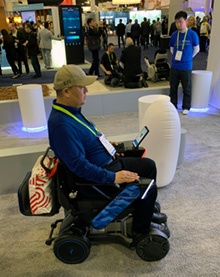See what the folks at WHILL have been creating as they showcase a few new products at this year’s CES
By Andy Nemann
Imagine being able to pull up to the airport, check your bags at the curbside, then be automatically taken to your gate without needing a wheelchair attendant or anyone else to push you.
That could soon be the way people with mobility issues such as spinal-cord injury and disease (SCI/D) get around airports and some other places, thanks to the latest creation from WHILL. The mobility company debuted its Autonomous Drive System (ADS) at the annual mega electronic trade show called CES this week in Las Vegas. Mounted on WHILL’s award-winning Ci model mobility device that debuted at CES last year, ADS works with a combination of beacons, sensors and a map of the specific location to find its way through whatever venue it’s traveling.
A Ci model using ADS has two sensors on the front and one sensor on the back to help prevent it from running into anyone or anything. Beacons placed throughout the location help the mobility device find its way through the venue. A map of the location appears on a tablet mounted to the Ci, and all you need to do is touch where you’d like to go and you’re on your way.
The system is currently undergoing testing at three airports around the world, and WHILL Director of Sales and Marketing Justin Gagnon says they have plans to expand ADS to other venues such as malls or museums and also see it as a way to help people get home.
“The long-term goal of it is to provide that last mile of transportation for folks,” Gagnon says. “So, if you get off public transport or even get an Uber to drop you off at a curb, some people have quite a way or quite a distance to go to navigate down the sidewalk to their home, their place of work or wherever they’re going, and we see this being able to bridge that gap for people.”
Besides the sensors on the Ci model, one of the big advantages of ADS is its use of beacons. Strategically placed beacons act as an electronic dot or marker, so the device always knows where it is and where it needs to go. Although beacons have to be placed throughout a venue first, Gagnon says using them allows the device to be more location-accurate than if it was using GPS. Using ADS doesn’t mean you lose control of where you’d like to go either. It’s not all automatic.
“So, you can tell it to go to your gate, and it’ll take you right there and you can sit and wait for your plane,” Gagnon says. “But if you want to go to the washroom or go to the Starbucks, you can tell it to go to the Starbucks and it’ll park you in front of the Starbucks, and you can take control of it manually from there. Drive through the line, get your order and then as you drive out you can say, ‘OK, I’m ready to go to my gate,’ and it’ll take you there.”
ADS is being tested at LaGuardia Airport in Queens, N.Y., and airports in Scotland and Amsterdam with between four and 10 devices in each place. Not designed for sale to the public, ADS is intended to be a licensing model with airports, malls or museums and eventually be a pay-per-use type of system for use on sidewalks after a person is dropped off by another service, such as Uber. The plan now is to expand to more airports with 40 to 50 of the devices available, depending on the size of the airport. Gagnon says WHILL is working with airlines to have the devices available to be booked when you make your flight reservations. He says response from the testing phase has been good.
“The feedback we’re getting from airport passengers is they love the independence,” Gagnon says. “Passengers love that they can go to the Starbucks or go to the bookstore and go to the washroom without having to have that person with them pushing them in a manual wheelchair that they’re used to today.”



